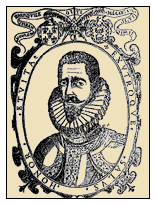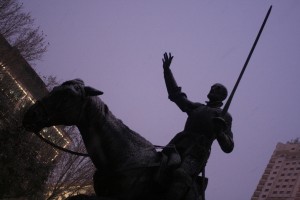Filed as Destreza (Spanish swordplay), Fencing, General, Historical Fencing with no replies
The General Tretas
The General Techniques (or Tretas) carry or capture the opposing weapon by creating a spiral with your own weapon.
|
|
Inside Line
(Spiral Counterclockwise)
|
Outside Line
(Spiral Clockwise)
|
|
Half Circle Spiral
|
General Technique of Narrowing
(Thrust by Glide)
|
General Technique of Weak Under
Strong
(Thrust by Detachment) |
|
Full Circle Spiral
|
General Technique of Weak Over
Strong
(Thrust by Detachment) |
General Technique of Line in Cross
(Thrust by Glide)
|
NOTE: All the descriptions below assume the opposing weapon is carried by the spiral instead of captured.
General Technique of Narrowing:
From an atajo on the inside line at MdP*, carry the opposing steel in a half
circle counterclockwise to the outside low line and terminate by stepping to
the right to deliver a gliding thrust to the chest.
General Technique of Weak under Strong:
From an atajo on the outside line at MdP*, carry the opposing steel in a half
circle clockwise to the inside low line and terminate by stepping to the right to
deliver a thrust by detachment to the chest.
General Technique of Weak over Strong:
From an atajo on the inside line at MdP*, carry the opposing steel in a complete
circle counterclockwise to the inside high line and terminate by stepping to
the right to deliver a thrust by detachment to the chest.
General Technique of Line in Cross:
From an atajo on the outside line at MdP*, carry the opposing steel in a
complete circle clockwise to the outside high line and terminate by stepping to
the right to deliver a gliding thrust to the chest.
Addition: The Generals can be combined together in such a way that the end of one may form the beginning of another without breaking the spiraling motion.
*MdP = Medio de Proporción or the Defensive Medio\Place.
Filed as Classical Fencing, Destreza (Spanish swordplay), Fencing, General, Historical Fencing with no replies

Don Luis Pacheco de Narváez
He is acerbic, often dogmatic, and difficult to like. Pacheco’s work at first glance would not seem to be an ideal metric by which to unify a tradition. Many people reading Pacheco for the first time have a strong negative reaction to the trollish way he jibes at the works of others. He does not resist the urge to throw punches in his prose and perhaps it makes him an early species of today’s internet troll who pokes and annoys others for his own amusement. Reacting to his tone, we might quickly dismiss him but the problem is that Pacheco is also an incredibly gifted technical writer and theoretician who is perhaps the most prolific fencing author in history. Most of the technical information we currently have about La Verdadera Destreza is a direct or indirect result of Pacheco’s work.
Carranza’s work does not contain enough technical material to describe a complete system. Thibault’s work is both extensive and technical but appears to be out of sync with the other authors. Most of the other La Verdadera Destreza authors available are derivative of Pacheco’s core system which means they are in some sense accountable to his examination standards. For this reason I often find myself presenting or defending Pacheco’s position as a common point of verifiable evidence even while I acknowledge that the tradition is broader than a single author.
The classical tradition that trained me enforces a core standard of practice with meticulous care. As an example, the hand in the invitation of second shall be held at a certain height and angle; to do otherwise is incorrect. However, if we examine the historical record, we see a multitude of different examples of the invitation in second and it might seem that this insistence on uniformity would be a compulsion which also borders on trollish antagonism towards the students. Why? What purpose does it serve?
By reducing scope in the school and during the examinations it creates right and wrong answers. That brief state of artificial purity allows students to develop their core skills and to carefully climb within a demanding system from ignorance into technical competence. As the students develop understanding and ability their own questions naturally arise which challenge the purity of the right and wrong answers.
An Instructor candidate should be able to recite the answers in the textbook and teach most of the actions described. The Provost candidates teach at a higher level and might qualify their answers, delve into difficult and broader theory, and occasionally explore concepts outside the textbook. The Master candidate is expected to not only be able to teach the textbook in its entirety but to also know when to leave it aside and justify the reasoning. The mastery of the lesson and execution becomes a personal expression which realizes the tradition as an act of creative art. An answer outside the scope of the book can become correct when good reason and judgment are applied.
William Gaugler’s fencing master’s program was not cloning human versions of his textbook but rather creating a common language and understanding by which a community could work outward to achieve nuanced understanding which could be both broad and deep. This might best describe the position from which Figueiredo wrote his Oplosophia; he has enough knowledge and expertise to master a tradition and yet uses his ability to provide critical expertise on the elements involved which challenges the canon of the tradition itself.
It is within this textbook form that Pacheco’s work shines. We have his proposed testing criteria and a large body of work which we can use to create a uniform standard for examination. A student citing Pacheco in his examination works from a defensible place of canonicity which provides a textbook of right and wrong answers. It forms a common core of theory and practice from which the students may safely learn in an elegant simplicity and ultimately transcend into multi-hued complexity.
Pacheco is not the only voice in our tradition but he is one of the great LVD authors and just as the textbooks in the classical program provide a beginning, mastery involves internalizing the work and seeing beyond the rules into the deeper and changing causes from which they are derived. Studying Pacheco diligently can become a Carrancine exercise in the search for verifiable science which can be taught and demonstrated.
For a Carrancine teacher Pacheco serves as a brilliant starting point, as a tool for teaching and examination, as an exercise in application, and as a historically uniform standard for evaluating knowledge and practice. Pacheco is a ready-made roadway from ignorance, through competence, into mastery. When that path is paired with Carranza’s instructions about teaching, science, art, and ethics we move from creating builders into creating architects.
Filed as Classical Fencing, Destreza (Spanish swordplay), Fencing, General, Historical Fencing, Italian Rapier, Opinion with no replies

There is no point in dreams if they lack some measure of audacity.
It was January of 2000 and the world had survived the millennium bug. The place was Breckenridge, Colorado and a member of my wife’s family had a cabin near the ski resorts. There at the top of the mountain I got my first bit of instruction in the ancient art of skiing.
The first and last thing I heard was, “Lean forward,” and so I did. I began to slide down the mountain gaining speed. I had no way to steer and no idea what I should be doing. I found myself completely out of control and was headed towards the trees at increasing velocity. Before I painfully crashed I orchestrated a controlled wipe-out into the snow with poles, skis, and limbs all flying in different directions. The remainder of the day was a repeat of the same series of leanings forward with various wipe-outs. I got better instruction and learned how to stop by “snow-plowing”. By the end of the day I had learned how to turn and stop with the skis parallel.
Sometime ago I became interested in the study of incompetence and how incompetent people generally behave. Specifically I was interested in the meta-cognition of incompetence as studied by Justin Kruger and David Dunning who found that incompetent people were unable effectively to evaluate their own competence. This lack of ability to understand personal competence has been called the Dunning–Kruger effect and restated basically it means that incompetent people tend to overestimate their own level of skill.
Link to the study:
https://www.math.ucdavis.edu/~suh/metacognition.pdf
(For an academic study, this is riveting material to read especially as a researcher, teacher, or student of martial arts.)
Compare that to Carranza’s statement, “He who knows most doubts most.” Carranza adds the perfect corollary to the DK effect and uniting the two ideas has given me a basis for moving forward during difficult tasks. (As an example, when a prairie-born Okie is rolling down a mountain with skis tied to his feet.)
The point isn’t to belittle or slander incompetence; we’re all incompetent in some subjects. Instead, my goal was to develop strategies to understand and mitigate my own incompetence by reserving a healthy dose of doubt about my own ability and creating a series of tests to validate my own performance.
I am going to add my own rule which I learned in Breckenridge, “Lean forward.” We can paraphrase Voltaire to arrive at a similar statement, “Never let the perfect be the enemy of the good.” If I had become paralyzed with the fear of the many stumbles, spectacular wipe-outs, and public laughter at my misbegotten antics I might never have learned to ski that day.
We might best understand this as a Medio (or a virtuous mean or balance point as Aristotle and the Destreza authors might describe it). There is absolute perfection at one extreme. At the other extreme is complete incompetence. Between the two extremes is the good work we might do if we just lean forward and accept our imperfection.
We need to teach and practice La Verdadera Destreza to build our skill and to foster a community. But, we also know not all the work has been translated which should be a warning to us to preserve our doubts. Previous attempts have stumbled and fallen quite publicly. Worse, our mistakes may be mocked and picked apart and ridiculed by our peers.
1. Know that your ability to self-evaluate is shaky while you are learning.
2. Preserve a healthy doubt and create meaningful checks to ensure your work is good.
3. Lean forward and be ambitious unto audacity. Don’t let the fear of failure prevent you from producing work.



